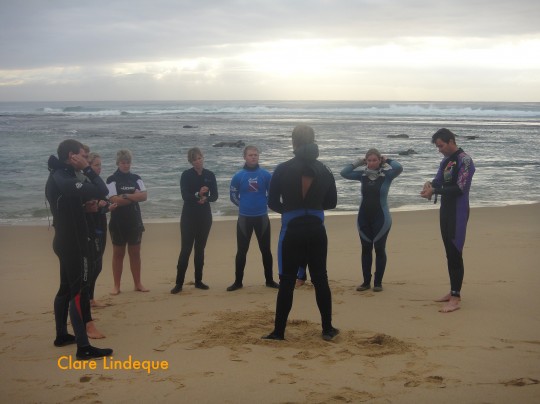Diving in Cape Town is often done without a Divemaster. Many of the dive sites are shore entries and quite often they are dived by casual divers and groups of friends.

Resort environments most often only conduct led dives, meaning there is a Divemaster that knows the site, the local conditions and the wildlife you will most likely encounter. These dives will invariably start with a dive briefing where the site will often be drawn on the sand or displayed in a book. The Divemaster will detail the site, the dive time, what percentage of you air will mean that you are “low on air” (often based on the depth, conditions and skills of the group), who leads, who follows and who buddies up with whom. Dive time and profile will also probably be based on the Divemaster’s computer. A good briefing will also cover lost buddy procedure, what to do in an emergency and the hand signals that will be used. Entry and exit techniques or special requirements will also feature. Some briefings will also include the signals for specific creatures.
In essence a dive briefing should cover as much as possible is a relatively short time (10 minute briefings will bore any diver to death) unless you are planning a very technical or potentially hazardous dive. The more you cover in a briefing the less chance of confusion underwater.
Diving, irrespective of the location is best conducted in a safe manner. (You get to do a lot more dives that way!) Understanding the weather, assessing the conditions and having some knowledge of the site goes a long way to ensure a good dive. Diving within your own ability also rates highly.
Cape Town offers the qualified diver a wide range of dives and the fact that there might not be a Divemaster with you does not mean you should not experience the dives. There are a few basics to consider, knowing the dive site is only possible after you have dived it a few times. Once you have decided to dive a site, read all the available information on the wikivoyage site for diving in Cape Town. This website will be your Divemaster. It will tell you how to get in and out, what skills and qualifications you need, depth, and the marine life to be expected. It will also tell you which weather conditions are best for the site. Pay close attention to the bearings if you want to see a specific feature, and know what the bearing is to get you back to shore.
Armed with all of this knowledge you and your buddy/buddies need only agree on a few issues before you set off. Plan your dive and dive your plan. If you agree it will be a 40 minute dive, stick to that. If you decide on who will lead then keep the order as such. Who your buddy will be and depth are important and it is important to agree on signals. As a qualified diver you are responsible for your own air so you need not have a Divemaster check it for you. If you are a group that dive together often then its best to base the dive time on the member with the worst air consumption, unless they are happy to return to shore alone. You will need a compass, and you will need to read the site details together to ensure you all have a good idea of the environment and likely conditions. You must have an SMB as this avoids the potential haircut you can receive from a passing boat.
It should not be required to cover this but I will ANYWAY, Make sure your equipment is proper, the correct size, and in serviceable condition. Don’t enter the water if you have an equipment malfunction or a leak or any other issue. Don’t think “we won’t be deep,” or “we won’t be far from the shore” and dive with faulty equipment. Should an emergency arise and you are swept out to sea, that small leak on you BCD will soon be a huge problem.
Diving is a very safe sport if you follow the rules, do the checks, and dive within your training. Do these things and you will have thousands of dives, each one often better that the last one.








Comments are closed.